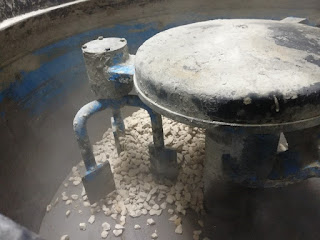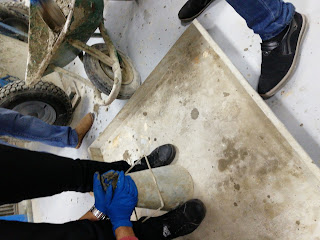CONSTRUCTION LAB REPORT: Concrete Mixing
CONSTRUCTION LAB REPORT
Concrete Mixing
Summary:
This blog post is a report of laboratory
concrete mixture, followed by a slump test to ensure good workability of the
concrete.
Introduction:
Concrete is a
mixture of cement, sand, aggregate, water, and possibly an admixture.
Proportions of each ingredient are adjusted to produce a well-balanced mix. Concrete sets in as few as 10 hours and continues to harden and cure as long as moisture and unhydrated cement are present. However, most of the increase in strength occurs within a few weeks.
Experimental
Procedure:
1.
For strength requirements, select the water to
cement ratio by weight.
2.
Before mixing concrete, be sure that the mixer
has been "buttered" with a mixture of cement, sand, and water.
3. Divide your water into two buckets, one with about 3/4 of the water.
4.
Put about half the coarse aggregate and the
3/4-bucket of water.
5.
Start the mixer.
6.
Add about half the fine aggregate.
7.
Carefully add all the cement with the mixer
running. Try not to make a lot of dust!
8.
Mix until all the cement is blended in.
9.
Add the rest of the coarse and fine aggregate.
10. Mix for a
while.
11. Add enough
water from the final quarter of the water to produce a workable mix.
12. Mix for three
minutes, followed by a three-minute rest, followed by a two-minute final
mixing.
Manual
results:
Mass of cement
= 10.855 Kg
Mass of fine
aggregates = 15.065 kg
Mass of coarse
aggregates = 22.816 kg
Mass of water =
5800 kg
The concrete mixture is finally added in cylindrical plastic molds after painting them with oil from inside.
Slump Test
Introduction:
WORKABILITY is
the relative ease or difficulty of placing and consolidating concrete. When
placed, all concrete should be as stiff as possible, yet maintain a
homogeneous, and void less mass.
Too much stiffness makes it too difficult or impossible to work the concrete into the forms and
around reinforcing steel. On the other hand, too fluid a mixture is also
detrimental.
The slump test is performed on newly mixed concrete.
Apparatus:
To perform the
test, you need a slump cone and a tamping rod. The slump cone, is 12 in. in
height, with a base opening 6 in. Both the top and bottom openings are
perpendicular to the vertical axis of the cone.
Cylindrical plastic molds are used to cast the concrete specimens.
Procedure:
· The molds
should be filled in three approximately equal layers.
· Each layer should be ridded (poked with a bullet-nosed steel rod) 25 times to eliminate unwanted air bubbles. The top of the molds should be struck off with the rod and then with a wooden float.
· Once the
specimens have been struck off, the outside of the molds should be cleaned as
well as the mixer and tools. Fresh concrete is a lot easier to clean than when
it has set.
· The cylinders should now be placed in the lab fog room for curing. After 24 hours a member of your group must strip off the mold and carefully mark your specimen with your group number.
· If the slump is less than required, return the concrete to the mixer, add the remaining water, and mix for one minute.
Results
of the slump test:
Depending on
the water-cement ratio of the mix, the concrete slump will fall under one of
four categories:
· True slump:
The
concrete largely retains its cone shape, demonstrating that the mix is cohesive
and its workability isn’t too high.
· Zero slump:
The
concrete retains its shape completely. This shows that the mix is very dry
(this kind of concrete is best used in road construction).
· Shear slump:
The
top half of the concrete subsides dramatically, leaning to one side, meaning
the mix has workability but low cohesion. The mix may have too much water
content and can be retested after being amended
· Collapse:
The
mix doesn’t retain its shape at all and completely collapses. This means the
water-cement ratio is too high and needs to be fully amended.
The concrete cylinders
are finally cured in water after 24 hours of the concrete mixture to have
stronger concrete.










Great post! This detailed explanation of the concrete mixing process is incredibly informative. I especially appreciate the step-by-step guide and the tips for ensuring a consistent mix. Looking forward to more insights from your future reports! https://www.intrax.com.au/
ReplyDeleteCivil construction and interior design are integral to creating functional and aesthetically pleasing spaces. While civil construction focuses on building robust infrastructures like roads, bridges, and buildings, interior design adds the finishing touch by optimizing the look and feel of interiors. Together, they ensure structures are not only durable and efficient but also comfortable and visually appealing.
ReplyDeleteGreat insights on concrete mixing! The detailed explanation of the process and its importance in construction helps enhance understanding. A helpful resource for anyone looking to improve their knowledge in the field. Building Information Management
ReplyDeleteThis article offers a clear overview of modern construction techniques and practical solutions. I appreciate how it simplifies complex processes and helps readers understand project planning better.Read more info about Civil Construction jobs Washington
ReplyDelete